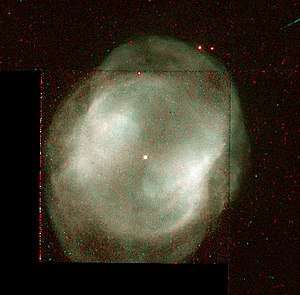NGC 3195
| Nebula | |
|---|---|
 | |
| Observation data: J2000 epoch | |
| Right ascension | 10h 09m 20.9s[1] |
| Declination | −80° 51′ 30.7″[1] |
| Distance | 5 500 ly |
| Apparent magnitude (V) | 11.6 |
| Apparent dimensions (V) | 40×35" |
| Constellation | Chamaeleon |
| Designations |
He2-44/ Hen 2-44 / Sa2-57 / |
NGC 3195 is a planetary nebula located in the constellation Chamaeleon. It is the most southern of all the bright sizable planetary nebula in the sky, and remains invisible to all northern observers. Discovered by Sir John Herschel in 1835, this 11.6 apparent magnitude planetary nebula is slightly oval in shape, with dimensions of 40×35 arc seconds, and can be seen visually in telescopic apertures of 10.5 centimetres (4.1 in) at low magnifications.
Spectroscopy reveals that NGC 3195 is approaching Earth at 17 kilometres per second (11 mi/s), while the nebulosity is expanding at around 40 kilometres per second (25 mi/s). The central star is listed as >15.3V or 16.1B magnitude. Distance is estimated at about 1.7 kpc.
References
- 1 2 3 "NGC 3195". SIMBAD. Centre de données astronomiques de Strasbourg. Retrieved 2007-04-17.